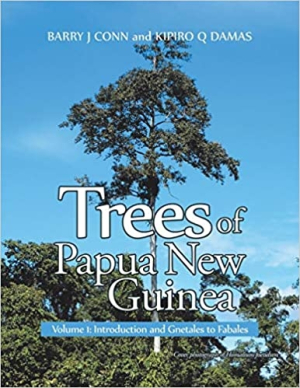Trees of Papua New Guinea
Volume 1: Introduction and Gnetales to Fabales
Trees of Papua New Guinea is a practical, in-depth guide to identifying that nation’s many species and varieties of trees.
Barry J. Conn and Kipiro Q. Damas’s Trees of Papua New Guinea documents tree species from across the island.
Papua New Guinea is home to some of the most biodiverse forests on Earth and, until now, their flora has never been thoroughly cataloged in one place. This book endeavors to fill the gap, identifying trees based on their seeds, fruits, bark, leaves, height, and other characteristics. This is done not just to encourage further study of these trees, especially by Papua New Guineans, but to ensure greater understanding of their uses and importance, before climate change and irresponsible logging do any further damage.
Trees of Papua New Guinea builds on prior research to describe and classify each tree in minute detail. A succinct introduction lays out the book’s methodology and goals. The rest of the book is devoted to compiling information on dozens of tree species into what is essentially a tree encyclopedia. Every element that may be of potential use in identifying a tree in the field is recorded, including the size and color of its leaves, the type and amount of hairs present, and whether exudate, if present, changes color upon exposure to air. Some trees are not as well studied as others, and the book points out where assumptions have been made or where data is lacking.
The book, though its scope is seemingly narrow, covers a great deal of territory. The variety of trees that call such a small island home, and even the variety found within a single tree species, is surprisingly broad and diverse. Although this is only the first of three volumes, it paints a meticulous picture of Papua New Guinea’s tropical forests.
The book takes a no-frills approach to its subject matter. It is well organized and intuitive to navigate. Maps show the approximate distribution of each species. Over one hundred and fifty illustrative figures include color photographs and sketches of selected trees’ notable features. Detailed references and an index enable further research and make it easy to locate specific pieces of information.
A glossary of terms is not included in this volume, necessitating the purchase of a complementary volume, independent research, or prior knowledge of botanical and taxonomic terminology. Not for new students or casual readers, the text is a tool that will most benefit serious researchers. It is dense with facts presented in a uniform, methodical manner and would make an excellent resource for those engaged in the study of Southeast Asian flora.
Trees of Papua New Guinea is a practical, in-depth guide to identifying that nation’s many species and varieties of trees.
Reviewed by
Eileen Gonzalez
Disclosure: This article is not an endorsement, but a review. The publisher of this book provided free copies of the book and paid a small fee to have their book reviewed by a professional reviewer. Foreword Reviews and Clarion Reviews make no guarantee that the publisher will receive a positive review. Foreword Magazine, Inc. is disclosing this in accordance with the Federal Trade Commission’s 16 CFR, Part 255.

